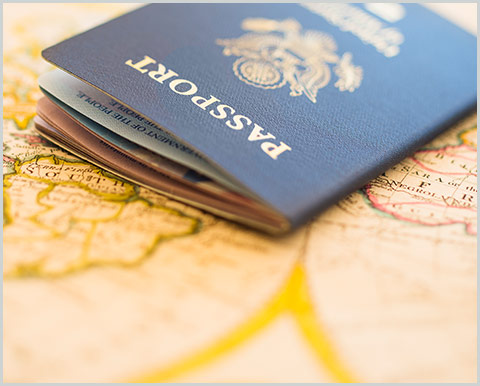|  Unmentioned in the raucous election-year debate over border security and building walls has been the existing digital drawbridge that individuals must cross when entering the United States. In the post-9/11 world, American border security has relied less on bricks than on innovative technologies and millions of lines of code. Unmentioned in the raucous election-year debate over border security and building walls has been the existing digital drawbridge that individuals must cross when entering the United States. In the post-9/11 world, American border security has relied less on bricks than on innovative technologies and millions of lines of code.
Technology solutions help verify that travelers are who they say they are when they present a passport or other travel document at the nation’s 328 ports of entry. These solutions prevent suspected terrorists from boarding U.S.-bound planes half a world away. They're used after individuals have been apprehended for illegally crossing U.S. borders.
And the government relies on Philadelphia-based Unisys to build, run and constantly update these digital defenses.
Unisys provides the engineering and IT solutions for over 500 inbound and outbound travel lanes where pedestrians and vehicles cross America’s land border. The layout of each port of entry is unique, and can even change based on the hour of the day, according to Amy Rall, Group Vice President for Unisys Federal, who leads the company’s Homeland Security and Critical Infrastructure practice.
To help meet this challenge, Unisys has developed intelligent digital signage that aids travelers by displaying targeted information in the morning, when most travelers are crossing the border on their way to work, and other types of information in the afternoon, when leisure travelers predominate. Not all port solutions are high tech: Simply painting feet on the ground to show travelers where they need to go has proven to speed travelers along. “Since we started implementing pedestrian lanes, we’ve cut wait times by over 20 percent,” Rall says. Unisys software systems read the RIFD chips or bar codes that are part of most U.S. and foreign passports and travel documents today, displaying within milliseconds a traveler’s biographical data pulled from remote databases controlled by U.S. Customs and Border Protection (CBP). Other Unisys technology reads vehicle license plates and gathers relevant information on a vehicle’s ownership and border crossing history. “And this technology needs to be able to read the plate when it’s 110 degrees and dusty, or when it’s minus 10 degrees and there’s a snowstorm,” Rall says. There’s little allowance for equipment breaking down, as ports of entry run 24/7/365. To maximize uptime, Unisys designs its systems to remotely monitor how well the equipment is functioning. About 90 percent of maintenance issues are identified remotely, the company says.  "We like to say we were the Internet of Things before the Internet of Things was a thing." "We like to say we were the Internet of Things before the Internet of Things was a thing."
- Amy Rall, Unisys
When it comes to searching people, vehicles and cargo containers, there’s simply too much crossing the border on a daily basis for everything to be thoroughly examined. Over 300,000 international air passengers enter the United States on a typical day, along with 280,000 privately owned vehicles and 72,000 truck, rail and sea cargo containers, according to CBP. That’s why Unisys’ supports one of CBP’s most important programs — the Automated Targeting System. Its algorithms determine whether passengers should be allowed to board U.S.-bound aircraft, barring those who might do the nation harm. In effect, it creates a risk profile that is based on information about each traveler and their cargo—such as whether the passenger bought a roundtrip or one-way ticket, or whether they paid with cash—that could give an indication of possible threats. Before Richard Reid tried and failed to ignite a bomb hidden in his shoe on a December 2001 Paris-to-Miami flight, such security work was still being done while flights were in the air. But after that thwarted attack, CBP required that security checks be completed before flights take off—even if that means doing them in just minutes between when the last passenger buys their ticket and the aircraft pulls away from the gate. Unisys had to implement that change in weeks. “Oftentimes, government IT is perceived to be very slow and bureaucratic,” says Rall. “But people who want to do harm to the United States are very agile. They’re constantly looking for ways to penetrate our strongholds. We can’t use normal methodologies and expect to be effective." “We have a mission tempo that matches national events,” she says. “We don’t encourage people to take time off during peak travel times like the holidays, because that’s when we have more travel, more cargo and more concerns about increased risks.” At border crossings, similar Unisys solutions help CBP officials determine which vehicles and containers have a higher risk of containing a wide variety of contraband. They go well beyond looking for worst-case threats like a dirty bomb, to search for shipments containing counterfeit goods, drugs, laundered money or agricultural pests, says Rall. When U.S. Border Patrol agents interdict someone who has crossed the border illegally, another Unisys software program that ties together government databases enables them to gather biographic information about the individual, look for instances when they’ve previously crossed the border, and see whether they have any outstanding warrants. The Border Patrol’s case file can then be handed off to U.S. Immigration and Customs Enforcement for removal proceedings, or to the U.S. Justice Department for prosecution. Unisys’ border security team of coders, systems integrators and other experts who work on these critical projects operate out of five anonymous buildings, most of which are in the Washington, D.C. area. But their focus is on those border security officials in the field, says Rall. “It’s much easier to design a system that’s used in an office environment than it is to design a system that’s used in difficult circumstances in the field, with big consequences if you get it wrong,” she says. “We take that very, very seriously.” “Content was curated by Bloomberg.” |